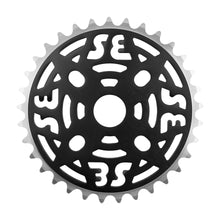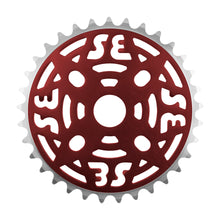The Se BMX One Piece Style Chainring and Spider Set is a high-quality component designed for BMX bicycles. It features a distinctive black chainring with precision-engineered silver teeth, complemented by a silver spider and accented with eye-catching ED gold bolts. This combination not only offers a striking visual appeal but also ensures durability and performance.
Specifically designed for compatibility with 1-piece cranks, this chainring and spider set is engineered to deliver reliable power transmission and withstand the rigors of BMX riding. With a tooth count of 39, it strikes a balance between speed and torque, making it suitable for a wide range of riding styles.
Constructed from alloy, this set combines strength and lightness, contributing to an efficient and responsive riding experience. The black and silver color scheme adds a sleek and dynamic look to your bike, while the gold bolts provide a touch of elegance.
This chainring and spider set is optimized for use with 1/2" x 1/8" chains, ensuring a secure and efficient connection. The tooth design is of the standard type, offering a reliable grip on the chain for consistent performance.
Whether you're a dedicated BMX rider or seeking to upgrade your bike's drivetrain, the Se BMX One Piece Style Chainring and Spider Set stands out as a top-quality choice. Its combination of aesthetic appeal, robust construction, and compatibility with 1-piece cranks makes it a valuable addition to any BMX enthusiast's setup. Ride with confidence, knowing that your bike is equipped with a component designed for both style and performance.
Specifically designed for compatibility with 1-piece cranks, this chainring and spider set is engineered to deliver reliable power transmission and withstand the rigors of BMX riding. With a tooth count of 39, it strikes a balance between speed and torque, making it suitable for a wide range of riding styles.
Constructed from alloy, this set combines strength and lightness, contributing to an efficient and responsive riding experience. The black and silver color scheme adds a sleek and dynamic look to your bike, while the gold bolts provide a touch of elegance.
This chainring and spider set is optimized for use with 1/2" x 1/8" chains, ensuring a secure and efficient connection. The tooth design is of the standard type, offering a reliable grip on the chain for consistent performance.
Whether you're a dedicated BMX rider or seeking to upgrade your bike's drivetrain, the Se BMX One Piece Style Chainring and Spider Set stands out as a top-quality choice. Its combination of aesthetic appeal, robust construction, and compatibility with 1-piece cranks makes it a valuable addition to any BMX enthusiast's setup. Ride with confidence, knowing that your bike is equipped with a component designed for both style and performance.

# A Guide to Bicycle Chainrings: Choosing the Right Replacement
Bicycle chainrings play a crucial role in the efficiency and performance of your bike. They are the toothed rings that attach to your crankset and engage with the bicycle chain. When it's time to replace a worn-out or damaged chainring, it's important to understand what factors to consider. In this guide, we'll cover the key aspects you need to keep in mind when buying a replacement.
1. Understanding Chainring Basics
a. Chainring Size
Chainrings are measured by the number of teeth they have. For example, a chainring with 52 teeth is larger than one with 42 teeth. The size affects the gearing ratio, influencing how easy or hard it is to pedal.
b. BCD (Bolt Circle Diameter)
Bicycle chainrings play a crucial role in the efficiency and performance of your bike. They are the toothed rings that attach to your crankset and engage with the bicycle chain. When it's time to replace a worn-out or damaged chainring, it's important to understand what factors to consider. In this guide, we'll cover the key aspects you need to keep in mind when buying a replacement.
1. Understanding Chainring Basics
a. Chainring Size
Chainrings are measured by the number of teeth they have. For example, a chainring with 52 teeth is larger than one with 42 teeth. The size affects the gearing ratio, influencing how easy or hard it is to pedal.
b. BCD (Bolt Circle Diameter)

This is a crucial measurement to get right. The BCD is the diameter of the circle that passes through the centers of the chainring bolts. It's important because it determines whether a chainring will fit on your crankset. Common BCD sizes include 110mm, 130mm, and 144mm, but there are others as well.

2. What to Measure
a. Number of Bolts
Check how many bolts secure your chainring to the crankset. This is typically either 4 or 5 bolts. It's important to get a replacement with the same number of bolts to ensure a secure fit.
b. BCD Measurement
To measure BCD, you'll need a ruler or caliper. Place one arm on the center of a bolt hole and measure to the center of the hole directly opposite. If you're not confident in your measurement, it's best to consult a professional or use specialized tools.

|
 |
 |
3. Things to Ensure Match
a. BCD Compatibility
Ensure that the BCD of your new chainring matches the BCD of your crankset. A chainring with the wrong BCD will not fit properly and can lead to poor shifting and potential damage.
b. Teeth Count
If you're happy with your current gear ratios, it's a good idea to stick with a similar number of teeth on your replacement chainring. However, if you want to adjust your gear ratios, you can experiment with different tooth counts.

|
 |
 |
a. Ignoring Wear and Tear
Don't delay replacing a worn chainring. A worn chainring can lead to poor shifting, chain slippage, and accelerated wear on other drivetrain components.
b. Mixing Incompatible Components
Avoid trying to force a chainring with the wrong BCD onto your crankset. This can lead to damage to both the chainring and the crankset.
Choosing the right replacement chainring involves understanding key measurements like BCD, teeth count, and bolt number. It's crucial to ensure compatibility with your existing components to maintain smooth and efficient operation. Remember, if you're uncertain, seeking advice from a professional at your local bike shop is always a wise move. With the right replacement, your bike will continue to perform at its best.






